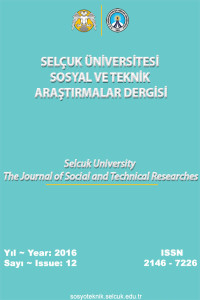Öz
Bu çalışmada Yükselen piyasa Ekonomilerinin almış olduğu doğrudan yabancı yatırımlar arasında bir yakınsama olup olmadığı analiz edilmiştir. Geleneksel ve β yakınsaması yerine literatürde daha etkin sonuçlar verdiği vurgulanan ikili yaklaşım kullanılmıştır. Analiz dönemi 1990-2015 olup 33 ülke ele incelenmiştir. Sonuç olarak bu ülkelerinin almış olduğu doğrudan yabancı sermaye akımlarında bir yakınsama tespit edilememiştir. Bu doğrudan yabancı sermaye yatırımlarının ülkelerin verdikleri destek/teşvik mekanizmalarından bağımsız olarak ülkelerin kurumsal yapılarından daha fazla etkilendiğini gösterebilir.
Anahtar Kelimeler
Kaynakça
- Acemoglu, D. and Robinson, J. (2010), The Role of Institutions in Growth and Development. Review of Economics and Institutions, 1 (2), 1-33.
- Bernard, A.D., Durlauf, S.N. (1996), Interpreting tests of the Convergence Hypothesis. Journal of Econometrics, 71, 161–173.
- Baumol, W. (1986), Productivity Growth, Convergence, and Welfare, American Economic Review, 76 (5), 1072-85
- Çatık, N. and Karaçuka, M (2012), A spatial approach To Measure Productivity Spillovers of Foreign Affiliated Firms in Turkish Manufacturing Industries, The Journal of Developing Areas, 46 (2), 65-83
- Feldstein, M. and Horioka, C. (1980), Domestic Saving and International Capital Flows, Economic Journal, 90 (358), 314–329 Gu, W. and Russell, R. R. (2010), Foreign Direct Investment and Convergence: A Nonparametric Production Frontier Approach,
- http://economics.ucr.edu/seminars_colloquia/2010/economic_theory/Gu%20paper%20for%203%208%2010%20seminar.pdf
- Kim, D.-H. and Trumbore, P. F (2010), Transnational Mergers and Acquisitions: The Impact of FDI on Human Rights, 1981–2006, Journal of Peace Research 47 (6), 723–734.
- Kottaridi, C. and Thomakos, D. D. (2007), Global FDI Convergence Patterns? Evidence from International Comparisons, Journal of Economic Integration, Center for Economic Integration, Sejong University, 22, 1-25.
- Kök, R. and Ersoy, B. A. (2009), Analyses of FDI Determinants in Developing Countries, International Journal of Social Economics, 36 (1/2), 105 – 123
- Mottaleb, K. A. and Kalirajan, K. (2010), Determinants of Foreign Direct Investment in Developing Countries: A Comparative Analysis, ASARC Working Paper 2010/13.
- Onyewuchi, O. G and Obumneke, E (2013), Multinational Corporations and the Nigerian Economy, International Journal of Academic Research in Business and Social Sciences, 3 (4), 359-369
- Quah, D.(1993), Galton’s Fallacy and Tests of the Convergence Hypothesis, Scandinavian Journal of Economics, 95 (4),427-43
- Quah, D. (1996), Empirics for Economic Growth and Convergence.European Economic Review, 40 (6), 1353-1375.
- Pesaran, M.H. (2007), A Pair-wise Approach to Testing for Output and Growth Convergence, Journal of Econometrics 138, 312–355.
- Pesaran, M.H., Smith, R.P., Yamagata. T. and Hvozdyk, L. (2006), Pairwise Tests of Purchasing Power Parity Using Aggregate and Disaggregate Price Measures, Cambridge Working Papers in Economics, 0634, Faculty of Economics, University of Cambridge.
- Pesaran, M.H., Smith, R.P., Yamagata. T. and Hvozdyk, L. (2009), Pairwise Tests of Purchasing Power Parity, Econometric Reviews, 28 (6), 495-521.
- Popovici, O. C. and Călin, A. C, (2014), FDI Theories. A Location-Based Approach, The Romanian Economic Journal, 17 (53), 3-24
- Sarıalioğlu Hayali, A. (2012), A Comparative Analysis of FDI in Terms of “Quantity” and “Quality”: Turkish Case, Ege Akademik Bakış, 3(12), 285-300
- Tanimoune, N. A. and Renard. M. F. (2005), FDI Convergence and Spatial Dependence between Chinese Provinces, 5th International Conference on The Chinese Economy, 20-21 October 2005
- Thomakos, D. D. and Kottaridi, C. (2006), Global FDI Convergence Patterns? Evidence from International Comparisons, Journal of Economic Integration, 22 (1), 1-25
- Tunca, H., M. Karaçuka ve A. N. Çatık (2013), A Meta-Frontier Approach to Measure Productivity Differences of Domestic and Foreign Affiliated Firms, Journal of Business Economics and Management, 14(4), 651–663
Ayrıntılar
| Birincil Dil | Türkçe |
|---|---|
| Konular | Finans |
| Bölüm | Araştırma Makalesi |
| Yazarlar | |
| Yayımlanma Tarihi | 31 Aralık 2016 |
| Yayımlandığı Sayı | Yıl 2016 Sayı: 12 |
Selçuk Üniversitesi Sosyal ve Teknik Araştırmalar Dergisi Creative Commons Atıf-GayriTicari 4.0 Uluslararası Lisansı (CC BY NC) ile lisanslanmıştır.


